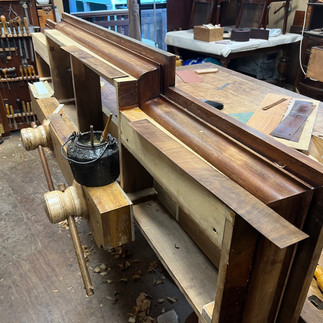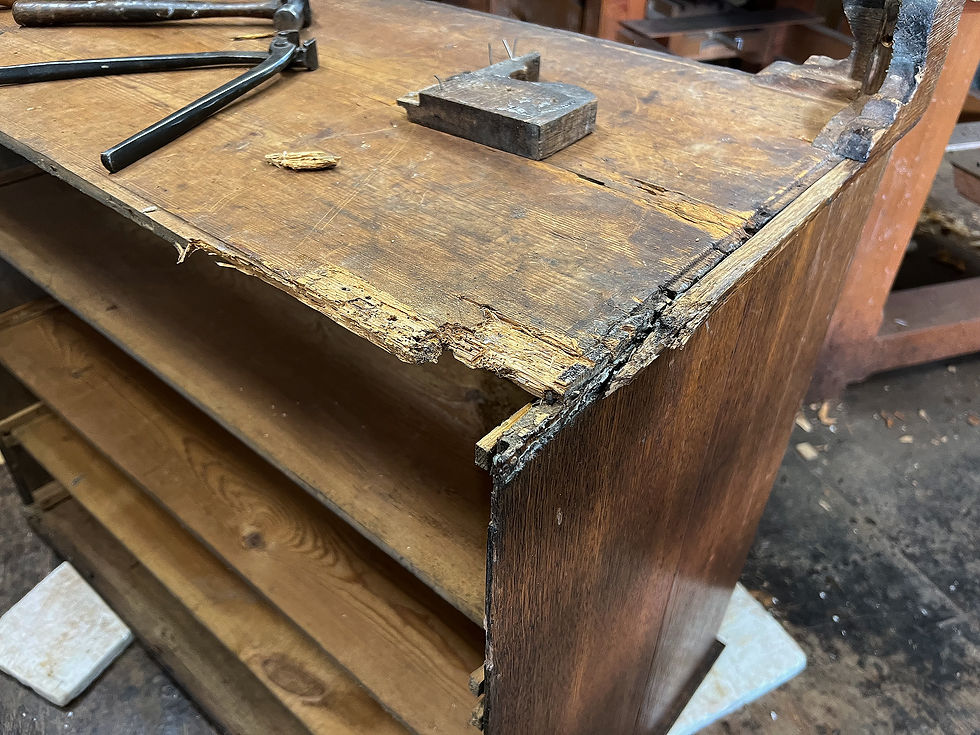What a mess
- Frank van Brunschot
- May 25
- 2 min read
Updated: Aug 22
Unfortunately in a modern and uncertain world floods are a part of life. In 2022 South east Queensland was badly flooded and suffered a lot of damage. Restoration and conservation work as a result of natural disaster is not infrequent. This article focuses on an antique William the 4th Bookcase which was badly water damaged.

William the 4th, 1830 to 1837. As shown in the photo above, this bookcase experienced significant water damage. The water damage was extensive, as well as being filthy all the veneers and joinery were falling apart. Although it's condition after the flooding was appalling on close inspection I could see that it had never been restored or re-polished and retained all original material with just a few old repairs. There was considerable deliberation over whether it should be restored or scrapped. Materials, (figured veneers and old Mahogany) can be salvaged from a piece like this and used to restore other items.
It was decided to restore this piece. It takes a big commitment from the client and the craftsman to restorer a piece like this. Often the cost of high quality restoration exceeds the market value of a piece. The above photos show some of the processes involved in taking it apart the bookcase. As the piece was saturated with water and starting to completely fall apart when I picked it up I decided to continue to disassemble it while it was still wet.

The whole bookcase came completely apart. Every individual piece of timber and veneer was carefully disassembled and cleaned. As the bookcase was put together with a traditional collagen based hide glue water could be used to soften it and take it apart.

Above a photo of the base, repaired, re-glued, re-blocked and the face veneers applied. The face veneers and all exposed polished surfaces have slowly aged over nearly 200 years to a lovely Mahogany colour. A lot of care was taken to keep all the original surfaces and material. This piece has not been sanded just carefully cleaned to remove residual and grime as well as removing some stains and discolouration. The old glue blocks and hand made nails were re-fitted and re-installed.
The above three photos show the process of repairing, re-glue and re-blocking the cornice.

The doors for the top section were fully repaired and re-glued. Dovetailed inset block were fitted as needed providing and secure frame for the face veneers.

Here is another photo showing the door under repair. After re-glueing the frames and applying the veneers, the bolection mouldings and astragal glazing bars were ready to be installed.

The four lower doors were flush panel doors, each featuring a large surface of crotch or flame Mahogany veneer. The frame was crafted from solid Mahogany using traditional frame and panel construction, with a captive panel that was flush-fitted to accommodate the figured Mahogany veneer.
Many of the applied carvings were damaged, with several missing. The carvings on the top doors were particularly thin and had broken in some areas. To repair and reinforce them, a piece of straight-grained Mahogany veneer was glued onto the backs of the top carvings at an angle to the grain.

Back together and finished.

Top section.



















